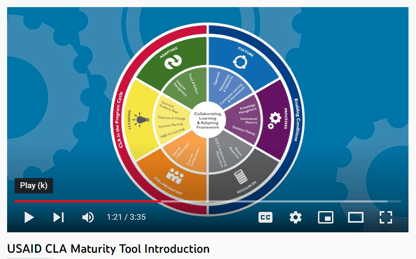USAID has been in the partnership business for a long time. And so have we, often working with USAID and other stakeholders in robust cross-sector collaborations to deliver global development and sustainable impact in many regions, sectors, and through innovative approaches.
Whether it’s access to clean water, women’s empowerment for inclusive supply chains, sustainable fisheries management, or harnessing entrepreneurial solutions through open innovation and innovative finance, as challenges become more complex, we often need strategies that are novel and creative.
At the same time, impact partnerships often deploy approaches that have a proven track record for addressing projects or processes. This is true of the Collaborating, Learning & Adapting (CLA) Framework utilized as part of USAID initiatives and activities with transferable value to private sector sustainable impact work as well.
What is The Collaborating, Learning & Adapting (CLA) Framework?
CLA is one approach to managing and improve effectiveness of complex development initiatives and activities adaptively and iteratively. It is a framework accompanied by guidance that recognizes strategic collaboration, continuous learning, and adaptive management link together all components in the Program Cycle.
In the simplest terms, incorporating with deliberateness effective CLA design across the entire initiative and programmatic activities can help development practitioners address challenges by thinking through:
Collaborating: Are we collaborating with the right partners at the right time to promote long-term synergy rather than designing approaches to solve an immediate problem without regard to future connectivity or integration with other systems?
Learning: Are we asking the most important questions and finding answers that are relevant to decision making?
Adapting: Are we using the information that we gather through collaboration and learning activities to make better decisions and adjustments as necessary?
Enabling Conditions: Are we working in an organizational environment that supports our collaborating, learning, and adapting efforts?
Borrowing directly from USAID in its efforts to ensure CLA becomes more systematic and intentional across the program cycle in the initiatives and activities it supports, we believe of CLA’s importance:
Integrating CLA into global development and sustainable impact work helps to ensure that programs are coordinated with others, grounded in a strong evidence base, and iteratively adapted to remain relevant throughout implementation.
The systematic application of CLA approaches, led by people who have the knowledge and resources to carry them out, enables USAID and its partners to be effective learning organizations and thereby a more effective development and implementing organizations.
How Can Impact Leaders Improve their CLA Capabilities and Expand their Toolkits?
Learning has always been a part of USAID’s work, and most USAID missions and implementing partners are already practicing CLA in some way (read more about our use of MEL approaches in our work, for example).
Given the effectiveness of CLA, USAID has dedicated resources through its Learning Lab to assist its staff and partnership teams to improve managing initiatives and activities adaptively through its use – from program design and start through implementation and evaluation.
Even outside of formal partnerships there is a great deal to learn for those who are wanting guidance on how to integrate and apply CLA practices in their own sustainability and impact work as well.
Here we describe a few of the many valued resources.
Online Intro Course on CLA in the Program Cycle
A good start is to take the online course - Introduction to Collaborating, Learning and Adapting (CLA) in the Program Cycle available for through the USAID Learning Lab.
In addition to a thorough overview, the course includes key questions to consider when planning a CLA approach and provides opportunities to think through six scenarios of using CLA. These provide a valuable active learning opportunity for participants to think through different applications of CLA in practice.
CLA Toolkit Sample: The CLA Maturity Tool
In addition to the online course, there is a robust Toolkit that represents collective best thinking about how to implement CLA to achieve better development outcomes (note certain resources are only accessible to those with access to USAID ProgramNet).
One widely used tool is the CLA Maturity Tool and Matrix, built from the Maturity Model, below, designed to provide a clear picture of what systematic, intentional, and resourced integration of CLA can look like throughout the Program Cycle and within a mission or partnership’s culture and processes.
Working through a set of cards as teams using this tool can catalyze conversations about CLA and enables learners and teams to:
Self-Assess: assess the current state of your CLA practice across the dimensions in the matrix.
Establish Vision: determine the aspirational future state for your CLA practice across the same dimensions.
Action Plan: through prioritization, identify where and how to focus future efforts to strengthen your CLA practice and develop your CLA Plan.
Track Progress: gain a snapshot in time and, when repeated in subsequent years, can help you track changes in CLA integration over time.
The video below demonstrates the way in which this tool can be utilized in practice.
This is just one of many tools available at the Learning Lab that help impact and partnership leaders further understand and develop capabilities in CLA planning, design and implementation, as well as engaging stakeholders and building culture.
CLA Can Yield Through Intentional Collaboration Improved Outcomes And Sustainable Impact
The dynamic cycle of CLA is ongoing and iterative. By looking to the past, present, and future, agencies like USAID and other organizations are seeking to coalesce partners and sector stakeholders around approaches that produce lasting results, measure those results in meaningful ways, and ensure that the important feedback loop between learning and adaptation continues.
Although intended initially as part of USAID missions and fortified across programs with more dedicated resources such as those through the Learning Lab, CLA frameworks have immense transferable value for private sector clients and cross-sector partnerships as well.
Whether embarking or embedding ESG, UNSDGs, Scope 3, or Sustainable Impact intiatives, CLA can be one of many guiding tools in effective change management for pressing breakpoint change that can lead to impactful outcomes long-term.


